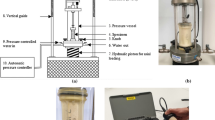Abstract
This paper examines the effects of mix compressive strength (30, 35 and 40 MPa) on the fracture initiation toughness, resistance-curve behavior and fatigue crack growth behavior of concrete mortar. The fracture initiation toughness and the resistance-curve behavior are shown to increase with increasing mix strength. The observed resistance-curve behavior is then attributed largely to the effects of ligament bridging, which are predicted using small- and large-scale bridging models. In contrast, the fatigue crack growth resistance is shown to decrease with increasing mix strength. An extended multiparameter framework was used for the modeling of fatigue crack growth. Finally, the implications of the results are discussed for the design of concrete mixtures with attractive combinations of strength, fracture toughness and fatigue crack growth resistance.




Similar content being viewed by others
References
Karihaloo BL, Nallathambi P (1989) Cement Concr Res 19:603
Jeng Y-S, Shah SP (1985) J Eng Mech 111:1227
Bazant ZP, Kim JK, Pfeiffer PA (1986) J Struct Eng 112:289
RILEM FMC-50, RILEM, “Materiux et Constructions” 18:287
Marchand J, Pleau R, Gagne R (1995) In: Skalny J, Mindess S (eds) Material Science of concrete IV, Acers, pp 283
Nordby Gene M (1958) ACI J 55:191
Bhalerao K, Shen W, Soboyejo ABO, Soboyejo WO (2003) Int J Concr Cement Compos 25:607
Bazant ZP, Xu K (1991) ACI J 88:390
Lou J, Soboyejo WO (2001) Metallurg Mater Trans 32A:325
Budiansky B, Amazigo JC, Evans AG (1988) J Mech Phys Solids 36:167
Tada H, Paris PC, Irwin GR (1999) The stress analysis of cracks handbook. American Society of Mechanical Engineers, New York, NY
Bloyer DR, Venkateswara Rao KT, Ritchie RO (1998) Metall Mater Trans A 29A:2483
Li M, Soboyejo WO (2000) Metall Mater Trans A 31A:1385
Fett T, Munz D (1994) Stress intensity factors and weight functions for one-dimensional cracks. Institut fur Materialforschung, Kernforschungszentrum, Karlsryhe, Germany
Paris PC, Gomez M, Anderson WE (1961) Trend Engineer 13:9
Soboyejo WO, Shen W, Lou J, Mercer C, Sinha V, Soboyejo ABO (2002) Int J Fatig 24:69
Acknowledgments
The research is supported by The Division of Mechanics and Materials of The National Science Foundation, with Dr. Oscar Dillon and Dr. Ken Chong as Program Monitors. Appreciation is also extended to Dr. Dan Davis for his encouragement and support of this work.
Author information
Authors and Affiliations
Corresponding author
Rights and permissions
About this article
Cite this article
Lou, J., Bhalerao, K., Soboyejo, A.B.O. et al. An investigation of the effects of mix strength on the fracture and fatigue behavior of concrete mortar. J Mater Sci 41, 6973–6977 (2006). https://doi.org/10.1007/s10853-006-0219-0
Received:
Accepted:
Published:
Issue Date:
DOI: https://doi.org/10.1007/s10853-006-0219-0




